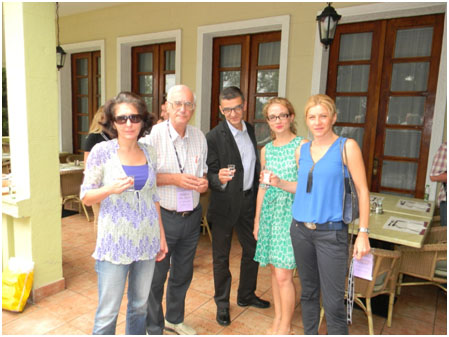As part of its program aimed at fostering the next generation talents in advanced materials and nanotechnology, the Centre for the Strategic Studies in Advanced Materials and Nanotechnology of the Materials Research Society of Serbia supported two young researchers, Dr. Ivana Jevremović, Research Associate at the Faculty of Technology and Metallurgy, University of Belgrade, was involved in the organization of the YUCOMAT 2016 conference as a member of the organizing Committe. We invited her to share hers impressions with us.

Dr. Smilja Marković Prof. Dr. Dragan Uskoković, Prof. Dr. Nenad Ignjatović, Dr. Ivana Jevremović, Dr. Dragana Jugović
The Eighteenth Annual Conference YUCOMAT 2016 was hosted by the Materials Research Society of Serbia onSeptember 5-10, 2016 at Hunguest Hotel Sun Resort, Herceg Novi, Montenegro. Conference organizers, honorable guests, wonderful speakers and conference attendees made this event truly a unique experience.
The success of the Conference was due to the excellence of the Conference Organizing and Technical Committees, the Sun Resort staff, and in particular Ms. Aleksandra Stojicic, the Conference Secretary. This year for the first time it was my honor to become a member of the Organizing Committee, while this was my second appointment as a Technical Committee member. From both an attendee’s and committee member’s point of view I can honestly say that YUCOMAT is a great conference, remarkably well organized, at a wonderful site, definitely worth experiencing again and again.
The Conference was initiated with an inspiring lecture delivered by the recipient of the 2016 MRS-Serbia Award, Dr. Gordana Vunjak-Novaković, Columbia University, USA, awarded for her achievements in the field of tissue engineering and regenerative medicine. In addition to a plenary talk by Dr. Gordana Vunjak-Novaković, invited plenary lectures were given by renowned scientist from all over the world. There were 5 plenary sessions with 30 speakers, with each speaker giving 30 minute talks. The first plenary session focused on biomaterial devices, nanoparticles for medical applications and the use of electron microscopy for characterization of thin film structures and novel engineering materials. The second plenary session provided some insight into how the existing spectroscopic techniques can be combined with the modern imaging techniques to obtain the detailed structure of various advanced nanomaterials. The third plenary session was about understanding the grain boundary atomic structures, atomic defects, different lattice parameters in various crystalline materials (2D materials, polycrystalline ceramics) as the key to improving their functional properties. The fourth plenary session was initiated with a lecture about the major trends in the field of photovoltaic devices engineering followed by a lecture on ferroelectric particles widely used in many memory devices and dielectrics. The lecture held by Serena Best on advances in regenerative medicine and the development of scaffold materials attracted special attention. Finally, the last plenary session summarized the findings related to failure and fatigue mechanisms of polymer fibers, microstructure, mechanical properties of austenitic steels and advanced biomaterials for cell carriers and drug delivery.
Furthermore, Conference was divided into seven symposia broadly ranging from basic research to the latest developments in the area of advanced materials with 33 speakers. The symposia covered the following topics: advanced methods in synthesis and processing of materials, advanced materials for high-technology application, nanostructured materials, eco-materials and eco-technologies, biomaterials, advanced hybrid and composite materials. The Symposium F on advanced hybrid and composite materials was held for the first time this year with the focus on research trends in hybrid materials processing technology. Scientists affiliated mostly with Korean, European and the United States institutions presented their work related to new trends in materials science, hybrid interface technology, novel and practical nanotechnology, thin film deposition techniques and the fabrication of 3D nanostructures. There were 60 multi-author posters in the traditional poster session which covered the wide range of research areas. The presenters reporting about their research or research related issues were approached for questions and discussion in a relaxed and informal setting.
In addition to the scientific part, the Conference also offered multiple networking/socializing opportunities for meeting up with colleagues from various fields and hopefully numerous future collaborations. Many of these relationships have been built during the Cocktail party, coffee breaks, bus trip to Dubrovnik, boat ride through the Boka Kotorska Bay and on many other occasions.
Dr. Ivana Jevremović, Research Associate
Department of Physical Chemistry and Electrochemistry
Faculty of Technology and Metallurgy, University of Belgrade, Serbia


